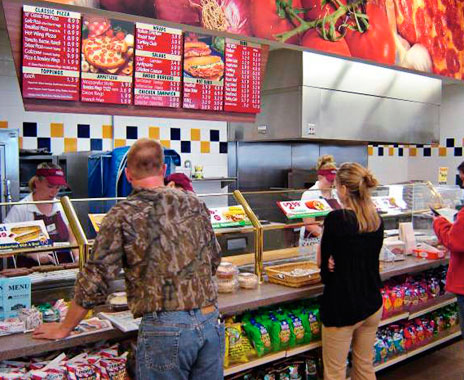Convenience stores have greatly improved their foodservice offerings in recent years, and a Technomic report released last month shows that those offerings may be stealing significant business from quick-serve restaurants.
Technomic’s “Consumer Brand Metrics (CBM): Convenience Store Shopper Insights Report” found that 26 percent of C-store customers would have purchased their meal or snack from fast-food restaurants if they had not bought them in convenience stores. Technomic surveyed more than 4,000 C-store shoppers in November and December.
Customers are buying food at C-stores in increasing numbers not only because of the convenience factor but also because of the food’s significantly improved quality and taste, says Darren Tristano, executive vice president of Technomic.
“Instead of roller hot dogs and heated pizza, we are seeing a more customized, higher-quality, and broader menu selection along with healthy food offerings from C-stores,” Tristano says.
Nine out of 10 C-store foodservice users say the quality and taste of the food are among important factors when deciding which C-store to visit. About 90 percent also said friendly service and a convenient location encourage them to purchase food at C-stores.
Americans’ increasing C-store use for their meals poses a real threat to quick serves, Tristano says.
“Fast-food restaurants have the most to lose from C-stores,” he says. “Fast food still has difficulty on a consistency basis providing good service.”
Nice N Easy Grocery Shoppers in Syracuse, New York, is one C-store chain that is effectively competing with restaurants by enhancing the quality of food it prepares, which includes baking its own breads, muffins, and cookies; purchasing high-quality proteins; and making its own line of popular pizzas.
“The average person doesn’t think of food at a gas station, so you have to exceed their expectations,” says Jack Cushman, executive vice president of food services at Nice N Easy.
The 89-unit chain offers restaurant-quality food in all of its stores and, in 25 units, sports a full-service Easy Street Eatery café. Unlike C-store foodservice programs that prepare food at a central commissary and then send it out to stores, Nice N Easy’s experienced foodservice staff makes nearly everything from scratch in stores. In addition, Nice N Easy stores feature a variety of entrées and sides sold as “home meal replacements” that can be warmed up at home.
“The first step, if you are providing fresh foods as a C-store, is acting as a commissary,” Tristano says. “The next step beyond that is to have custom, made-to-order products available for customers. For example, a sandwich prepared for you, in front of you … made with fresh, quality bread, good proteins, sauces, and flavors.”
Pennsylvania-based Wawa, with 625 stores across the U.S., has quickly become the poster child for how to do C-store foodservice right, Tristano says.
“They raise the bar of both the consumer expectations and what operators have to do to remain competitive,” he says. “What Wawa does is going to continue to shift demand toward C-stores and away from fast food players.”
In its survey of C-store shoppers, Technomic found that Wawa’s foodservice offerings received the highest possible scores across 11 attributes, including quality, variety, and the craveability of its menu items. Some 92 percent of C-store foodservice buyers said that Wawa’s service and hospitality were “good” or “very good.” Sheetz, Quick Trip, Stripes, and Kwik Trip also earned high marks across all categories.
Still, thanks to 7-Eleven’s unit volume, as well as improved foodservice offerings, more C-store customers buy 7-Eleven’s foodservice fare than any other chain. Thirty-nine percent of foodservice users purchased a food item from 7-Eleven in November and December, according to Technomic.
While 7-Eleven, Wawa, Sheetz, and others are some of the most publicized examples of C-stores doing improved foodservice, it’s many of the smaller, regional chains, like Nice N Easy, that could prove to be the most legitimate competitors to quick service.
Nice N Easy’s foodservice staff is even structured like many national quick-serve franchises. The foodservice staff features restaurant managers at each Easy Street Eatery unit who report to district managers, and the C-store chain also has two full-time executive chefs. With its focus on providing restaurant-quality food for a value and in a convenient location, Nice N Easy has grown its foodservice business to make up around 26 percent of all in-store sales.
Foodservice is growing at C-stores not only because of operators’ focus on quality ingredients and preparation from scratch, but also because of younger consumers’ willingness to try C-store food offerings, Cushman says. “Younger people don’t have that negative connotation with gas station food that our generation has,” he says.
Smaller, hybrid grocery/C-store combinations are also offering new competition to the quick-serve industry. Portland, Oregon–based Green Zebra Grocery, which opened its first store in the city last fall, offers freshly prepared food along with packaged goods in a C-store format. Green Zebra sells a variety of grab-and-go foods made with healthy and local ingredients, such as local produce, sustainable seafood, and grass-fed beef, alongside other C-store staples such as Gatorade and Doritos.
“We are different in that we are healthy and convenient, and no one else is really competing in this space,” says Lisa Sedlar, president and CEO of Green Zebra Grocery.











